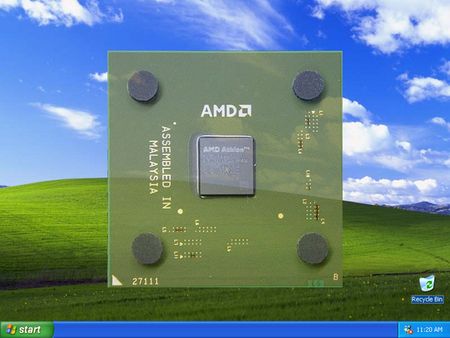Imitation To Innovation: AMD's Best CPUs
AMD Improves the Athlon: Thunderbird, XP, and more.
AMD knew it had a winner with the K7 architecture and improved it little by little, increasing the frequency and using finer fab processes. The Thunderbird core employed a 180 nm process and had 256 KB of on-chip cache. The Palomino design introduced support for SSE. The Athlon XP changed the package and reinstated PR numbers. The Thoroughbred was an Athlon XP using a 130 nm fab process (with a 256 KB cache). Barton had a 512 KB cache and also used a 130 nm process. Athlon XP and subsequent models used the PR number instead of a clock frequency designation.
| Code name | Thunderbird | Palomino/XP | Thoroughbred | Barton |
| Date released | 2000 | 2001 | 2002 | 2003 |
| Architecture | 32-bits | 32-bits | 32-bits | 32-bits |
| Data bus | 64-bits | 64-bits | 64-bits | 64-bits |
| Address bus | 32-bits | 32-bits | 32-bits | 32-bits |
| Maximum memory | 4,096 MB | 4,096 MB | 4,096 MB | 4,096 MB |
| L1 cache | 64 KB + 64 KB | 64 KB + 64 KB | 64 KB + 64 KB | 64 KB + 64 KB |
| L2 cache | 256 KB (CPU frequency) | 256 KB (CPU frequency) | 256 KB (CPU frequency) | 512 KB (CPU frequency) |
| Clock frequency | 650-1,400 MHz | 1,000-1,733 MHz | 1,200-2,250 MHz | 1,400-2,200 MHz |
| FSB | 100/133 MHz (DDR) | 133 MHz (DDR) | 133/166 MHz (DDR) | 166/200 MHz (DDR) |
| FPU | built-in | built-in | built-in | built-in |
| SIMD | MMX, Enhanced 3DNow! | MMX, Enhanced 3DNow!, SSE | MMX, Enhanced 3DNow!, SSE | MMX, Enhanced 3DNow!, SSE |
| Fabrication process | 180 nm | 180 nm | 130 nm | 130 nm |
| Number of transistors | 37 million | 37.5 million | 37.2 million | 54.3 million |
| Power consumption | 38-72 W | 46-72 W | 49-68 W | 60-76 W |
| Voltage | 1.7-1.75 V | 1.75 V | 1.5-1.65 V | 1.65 V |
| Die surface area | 120 mm² | 129.26 mm² | 84.66 mm² | 100.99 mm² |
| Connector | Socket A | Socket A | Socket A | Socket A |
We should mention that AMD also produced versions for servers (Athlon MP) and for laptops (Athlon 4, Athlon XP Mobile), as well as the Geode NX (130 nm and a 256 KB cache). AMD marketed the Thorton (130 nm, 512 KB of cache, 256 KB of which was disabled) and planned on Trinidad, an Athlon using a 90 nm process. There were more PR oddities: the Athlon XP 2600+ was clocked at 1,900, 1,917, 2,000, 2,083, or 2,133 MHz depending on the version, for instance.
Get Tom's Hardware's best news and in-depth reviews, straight to your inbox.
Current page: AMD Improves the Athlon: Thunderbird, XP, and more.
Prev Page K7/Athlon: A Killer Next Page Duron and Sempron: AMD's Celerons